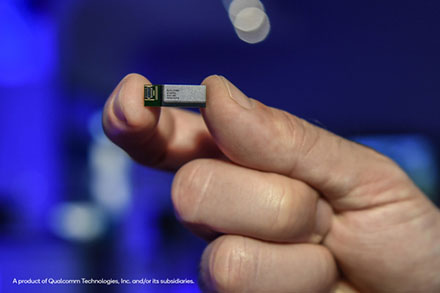|
In July 2018, Qualcomm Technologies unveiled the world’s first fully integrated fifth-generation (5G) New Radio (NR), millimeter wave (mm-wave), and sub-6-GHz radio-frequency (RF) modules for smartphones and other mobile devices.
The Qualcomm QTM052 mm-wave antenna module family and the Qualcomm QPM56xx sub-6-GHz RF module family pair with the Qualcomm Snapdragon X50 5G modem to deliver modem-to-antenna capabilities across several spectrum bands in a very compact footprint suited for integration in mobile devices.

To date, mm-wave signals have not been used for mobile wireless communications due to the many technical and design challenges they pose, which impact nearly every aspect of device engineering, including materials, form factor, industrial design, thermals, and regulatory requirements for radiated power.
The QTM052 mm-wave antenna modules work in tandem with the Snapdragon X50 5G modem as a comprehensive system to help overcome the challenges associated with mm-wave. They support advanced beamforming, beamsteering, and beamtracking technologies, improving the range and reliability of mm-wave signals.
They feature an integrated 5G NR radio transceiver, power management integrated circuit, RF front-end components, and phased-antenna array. The modules support up to 800 MHz of bandwidth in the 26.5–29.5-GHz (n257) range as well as the entire 27.5–28.35-GHz (n261) and 37–40-GHz (n260) mm-wave bands.
Most importantly, the QTM052 modules integrate all of these capabilities in a very compact footprint so that up to four of them can be integrated in a smartphone.
This allows original equipment manufacturers to continue evolving the industrial design of their mobile devices, offering attractive form factors combined with the benefits of extremely high speeds from mm-wave 5G NR, thereby making such devices available for launch as early as the first half of 2019.
Full article: IEEE Vehicular Technology Magazine, Volume 13, Number 4, December 2018 |